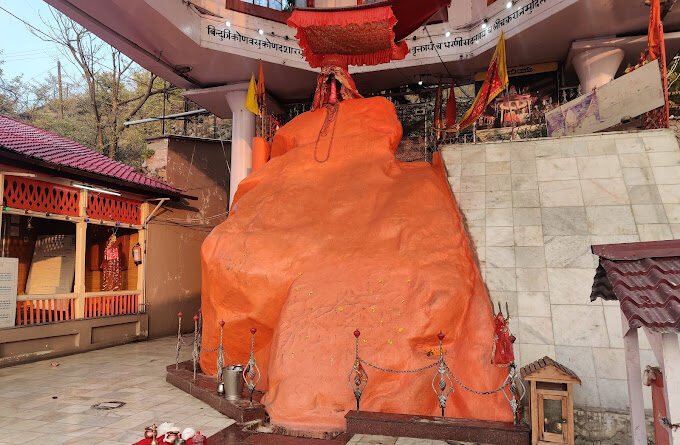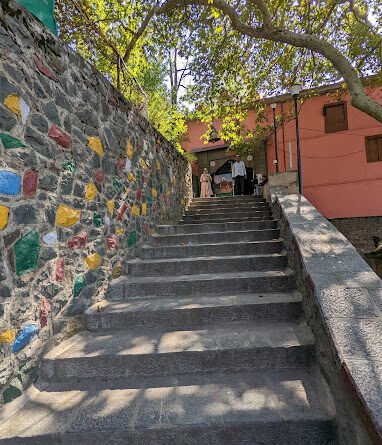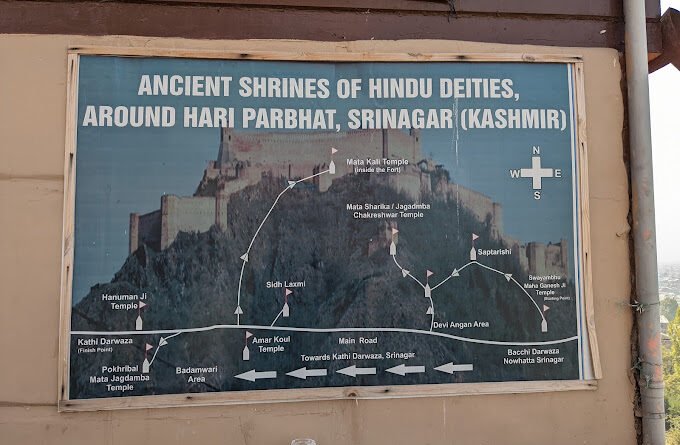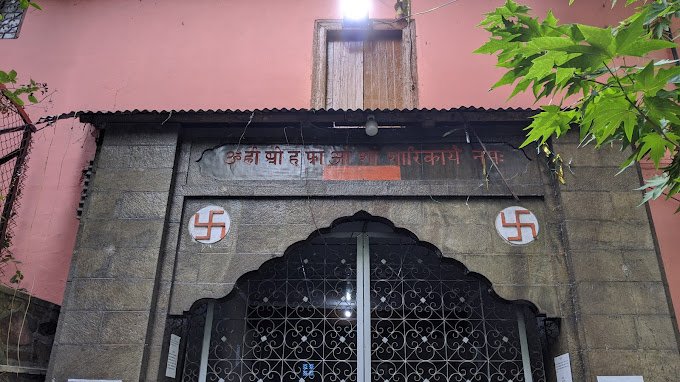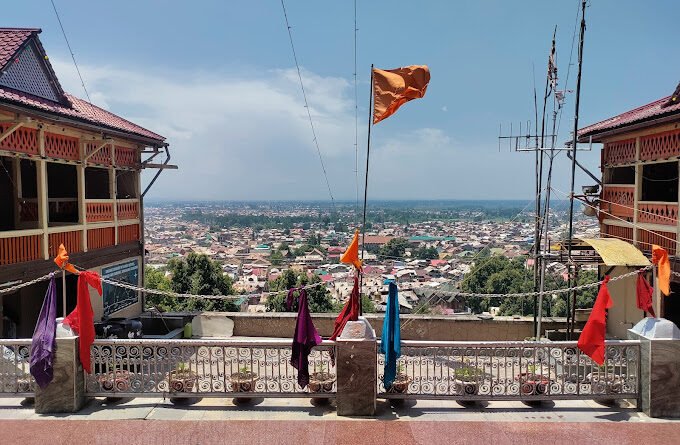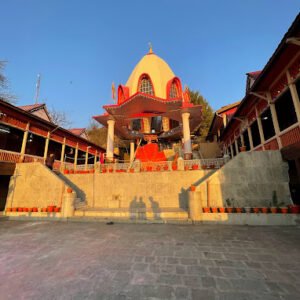Chakreswari Sharika Devi In Hari Parbat Fort Srinagar
Hari Parbat is a hill overlooking Srinagar, the largest city and summer capital of Jammu and Kashmir, India. It is the site of a Durrani fort, built in 1808. It has the famous Shakti Temple on the western Slope and Muslim shrines of Khwaja Makhdoom Sahib and Akhund Mullah Shah on the southern slope. On the southern side of the outer wall there is a Gurudwara, which commemorates the visit of Guru Hargobind.
The first fortifications on the site were constructed by the Mughal emperor Akbar in 1590. He built an outer wall for the fort, and planned a new capital called Nager Nagor to be built within the wall. That project was never completed. The present fort was built in 1808 under the reign of Shuja Shah Durrani.
The hill is considered sacred by the Kashmiri Pandits due to the presence of temple of Sharika. Temple is of goddess Jagadamba Sharika Bhagwati. She has 18 arms and is regarded as the presiding deity (`isht`-Devi) of Srinagar city. The goddess is represented by a Swyambhu Shrichakra (Mahamaha Shrichakra), also called Mahashriyantra, which consists of circular mystic impressions and triangular patterns with a dot at the center. Sharika Devi is believed to be a form of Durga Mata or Shakti.
Hari Parbat Fort is an ancient fort in the state of Jammu and Kashmir that dates back to the days of Mughal. Originally, the fort was built by Mughal Emperor Akbar but its present edifice owed itself to the Afghan governor Shuja Shah Durrani, who ruled Kashmir during 18th century. The fort is epitome of religious shrine. It has Sharika Devi Temple on its western slope and the Muslim shrine of Makhdoom Sahib and Akhund Mullah Shah on southern side. Sikh holy shrine of Gurudwara Chatti Patshahi has also enshrines within the premises of the fort. The Kathi Darwaja is the main entrance to the fort.
The shrine of Sharika Devi can be neared from Deviangan by a flight of chiselled stone steps, numbering 108. Then number 108 has mysterious implications in Hindu mythology. It is perhaps due to the Shrichakra that the capital city of Kashmir is said to have derived its name of Srinagar (Shrinagra). According to the ‘Visishtadhvaita’ doctrine, ‘Shri’ is the divine consort of the Lord and is said to play the intermediary between God and human soul. The shrine of Chakrishwar has been a place of worship from the day Goddess Sharika demonstrated herself in the form of a ‘shila’ (small rock) on the Hair Parbat. The days of Phagun Krishna Paksh Ashtami (Hora Ashtami) and Ashad Shukla Paksh Saptami, Ashtami and Navami (Har Satum, Har Aatham and Har Navum) are the auspicious days for the devotional prayers at the Sharika Temple peeth. Ashad Navami (Har Navum) is said to be the birthday of Sharika Bhagwati.
On this day of Sharika Jayanti, devotees make sacrificial offering of ‘Teher-charvan’ (rice boiled with turmeric powder and mixed with oil, salt and cooked liver of goat) to the Almighty Goddess. This ritual is locally known as ‘Chout Kharoun’. On ‘Navreh’, (the New Year Day of Kashmiri Pundits) during the month of Magh and throughout Navaratri, devotees regularly visit the Hari Parbat for special prayers and worship.
Architecture Of Hari Parbat:-
Hari Parbat Fort is the ancient heritage site of a Durrani Fort which was erected in 1808, however; it was in 1590 when its first fortifications were built under the instructions of Mughal Emperor Akbar. The Mughal Emperor had the outer wall of the Fort erected to plan a new capital for his kingdom by the name of Nagar Nagor to be established within the confines of this exterior wall. This project was however left incomplete. The construction work was resumed in 1808 when J&K was under the reign of an Afghan Sultan named Shuja Shah Durrani after whom, the Fort was also named as the Durrani Fort.
Hari Parbat Fort is the original fort of the Mughals perched atop the stunning Sharika Hill of Kashmir. It was aptly constructed on the riverbanks of the Dal Lake offering one of the most breathtaking views to cherish thus accentuating the splendid beauty of its surroundings.
Hari Parbat Fort is formidably secured on an elevated altitude that commands a panoramic vista of the Dal Lake fringed with Chinar trees and a small Char Chinar island that nestles amidst a lush umbrage gleaming over the lake with luster. The imposing Fort structure is surrounded by almond orchards showcasing a spectacular sight during April when they blossom to the hilt thus announcing the advent of the colourful spring season in Kashmir.
The southern end of the outer wall of the Hari Parbat Fort is Gurdwara Chhati Patshahi that commemorates the visit of Guru Har Gobind to Kashmir at Kathi Darwaja in Rainwari, Srinagar. This is a highly revered Sikh Gurudwara in Kashmir and is believed to have been blessed by the visit of the sixth guru of Sikhism who once traveled through Kashmir occasionally preaching. He stopped by this Gurdwara and stayed here for few days before continuing on his journey across lands.
Apart from the Gurudwara, there are 2 highly revered Muslim shrines of Khwaja Makhdoom Sahib and Akhund Mullah Shah enshrined on the southern slope within the precincts of this imposing Fort while the sacred shrine of Sheikh Hamza Makhdoom (also referred to as Sultan-Ul-Arifeen and Mehboob-ul-Alam), nestles below the Hari Parbat Fort towards the southern end of Koh – e – Maran Hill.
Featuring 2 floors and many pillars, the Muslim Shrine structures display an ancient architecture that appeals to many intrigued tourists. They are largely visited by believers of all faiths, and cultural backgrounds throughout the year making it a highly respected shrine belonging to a Sufi saint, who was also known by the name of Hazrat Sultan.
A famous Hindu Shakti Temple lies on the western slopes of the Hari Parbat Fort and is referred to as the Sharika Mata Temple considered highly sacred by the Kashmiri Pundits. A life-size statue of the presiding Deity, Goddess Jagadamba Sharika Bhagwati, who is known to be a form of Durga Mata or Shakti, features 18 arms and is represented by a Swayambhu Shri Chakra or Mahamaha Shri Chakra, collectively named as the Maha Shri Yantra comprising of triangular patterns and mystic circular impressions with a red dot at the center.
Interesting fact about fort: The Dogra rulers arrested the first prime minister of Kashmir Sheikh Mohammad Abdullah and lodged him in this fort in 1931
The Old Wall And Fort Decors:-
The wall stretches for 5-km and is 10 metres high and has two gates, the Kathi and Sangin Darwaza. The Kathi is the main entrance with Persian commemorative inscriptions surrounding it. The Sangin, however, is more ornate with sculptured windows on either side.
Visits to the fort, now used as an arsenal, are only possible with written permission from the director of tourism so for most visitors the fort will remain just a pleasant backdrop. The fort contains a temple revered for its image of the Goddess Sharika.
History of the Fort:-
The first protection walls to this fort were provided by Mohammed Khan. He built this outer wall and nestled a capital city inside named as Nager Nagor but this vision could never be completed. The present temple was reconstructed in 1808 under the rule of Shuja Shah Durrani and hence this fort is also called as Durrani fort sometimes.
The temple goddess at Sharika Mata temple is an 18 handed deity. This goddess is represented as a swayambhu chakra, also called as mahashriyantra which is kept in many homes as a good luck charm. She also believed to be a form of goddess Durga.
Legendary Origin
According to one legend, at the place Hari Parbat stands today was a huge lake. A demon named Jalobhava resided here. Local inhabitants prayed goddess Parvati to get rid of the demon. She took a small pebble and threw it on the head of this demon. The pebble kept growing until it completely crushed his head. Locals believe this pebble turned into the present Hari Parbat and became the home of gods and goddesses.
Another story tells that there were two demons, Tsand and Mond who lived in this valley. They both troubled villagers here by hiding at where the present day Hari Parbat and Mond at Dal Lake Gate. Goddess Parvati came to rescue villagers by taking the form of a small bird and threw a pebble on Tsand which grew into a large size and transformed into Hari Parbat. That is how Parvati is worshipped here as Sharika. This part of the hill is also called as Predemna peeth.
According to the another version of the folklore, the two demons, Chand and Mund lived in the Kashmir Valley. Chand lived in the water near the current site of Hari Parbat and Mund lived around Dal Gate. These demons terrorised the people. The gods invoked Shakti. She manifested herself into a Hari (myna) and flew to Sumer. She carried a pebble in her beak and dropped it on Chand. The pebble transformed into a huge mountain, crushing the demon. It was later named as Hari Parbat.
Temple Legend:-
Legend has it that in the medieval era, Kashmir was a big lake called “Satisar”. It was inhabited by a water demon, named Jalodbhava who tortured and devoured the local inhabitants. The inhabitants approached sage Kashyap, the grandson of Brahma. He did an intense penance to rescue people from the demon. Pleased with his penance almighty blessed him. Hence, he was able to cut the mountain. Due to which the lake dried up and the demon was killed by divinely dropped a pebble on this head. The pebble kept growing larger until the demon was dead. The pebble today stands as “Hari Parbat” and is said to be a home of all the gods.
Significance of the Hari Parbat Temple:-
After visiting the Hari Parbat, King Chakreshwar is believed to have worshiped all the Gods and Goddesses of Hindu Mythology and had obtained all his worldly desires and wishes. Therefore, it is believed that Saints and Yogis achieved the ultimate on worshiping at this Sharika Peeth. Thus most people visit the temple to get all their wishes fulfilled.
Hari Parbat Temple Timings
The temple is open for all devotees at any time of the day. Also people of all caste or creed can visit the temple as it does not distinguish between them. The timings for the temple are from 6AM to 10PM. Tuesday is considered a special day for all devotees and a large number of worshipers visit the temple. On fulfillment of wishes people offer gifts and sarees in the temple and promises are also made before the deity.
Festivals Celebrated At the Hari Parbat Temple:-
The Chakrishwar Shrine is a popular place of worship in the temple. Goddess Sharika had look as if here at Hari Parbat as a ‘shila’ (small rock) which has augmented the religious implication of the hill top. Sharika Bhagwati’s birthday is celebrated on the Ashad Navami (Har Navum) which is an imperative occasion in the temple. Other propitious days when worshiping prayers are offered at the Sharika Temple Peeth are the Phagun Krishna Ashtami (Hora Ashtami), Ashad Shukla Saptami, Ashtami and Navami (Har Satum, Har Aatham and Har Navum).
Poojas and Ritual at Hari Parbat Temple
The temple is devoted to Goddess and hence the customs are the same that are offered to the Goddess in the region. The Kashmiri Pandits implore here with special chants and mantras and the poojas last as long as the implication of the occasion. During Navratri, special poojas are performed here and the Goddess is offered special prasadam and is decorated with all beautiful clothes. There are many fairs and procession carried out in and near the temple during this time of the year.
Nearby Places to Visit:-
Chatti Padshahi:-
There is shrine of Chatti Padshahi in Jammu & Kashmir dedicated to the sixth Master of Sikhs. Found in the area of Kathi Darwaza of Srinagar in J& K valley, it commemorates the coming of the sixth great Guru of Sikhs. It is said that the Guru traveled from place to place to impart his message of peace and brotherhood. There is a spot found in Srinagar where Chatti Padshahi stands and it is this place where the Sikh Master arrived and stayed back for quite some time.
The dedicated followers of Sikh religion who live in Jammu & Kashmir come to visit the Chatti Padshahi shrine frequently to seek their Guru’s blessings. Visitors from different states of the country are seen visiting this popular shrine of Srinagar just for having a glimpse of this pious aura that surrounds this place.











